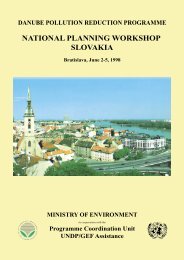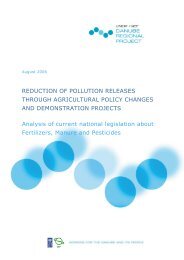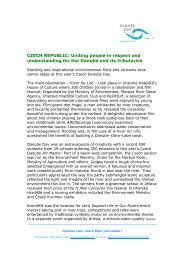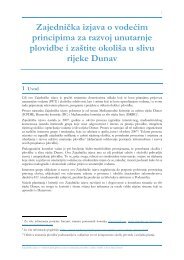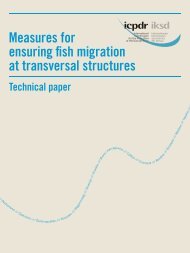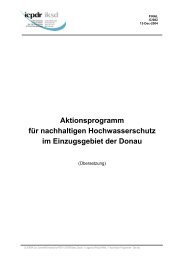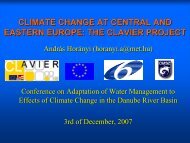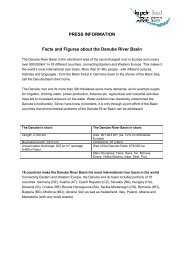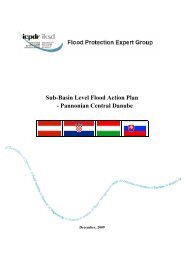Technical Reports Parts C,D - ICPDR
Technical Reports Parts C,D - ICPDR
Technical Reports Parts C,D - ICPDR
Create successful ePaper yourself
Turn your PDF publications into a flip-book with our unique Google optimized e-Paper software.
2. Updating of Hot Spots<br />
Major municipal pollution sources are cities with the population over 100.000: Chernivtsy, Izmail,<br />
Mukachevo, Izmail; capacity of municipal wastewater treatment facilities is less than required by<br />
1,5 - 2 times. Kolomyia with population about 70.000 may be included in the list of priority hot<br />
spots because its wastewater treatment facilities are overloaded by more 1,5.<br />
The small towns with population more than 10.000 such as Kylia, Reni, Khust, Svaliava, Berehove,<br />
Vynogradiv, Rakhiv require the improvement of wastewater treatment facilities including<br />
reconstruction, renovation of facilities and construction anew. At the Ukrainian territory of the<br />
river Danube basin there are over 20 such small towns. Considering the future socio-economic<br />
development this problem has to be taken into account very seriously.<br />
For small towns and villages with population less than 10.000 (Solotvino, Zastavne, Chop), all<br />
together 40, the wastewater treatment facilities should be constructed/reconstructed as well.<br />
There are three directions for reduction of pollutant discharges from industrial sources.<br />
The first one is the improvement and modernization of technological processes at the wood<br />
processing, timber processing and paper plants, especially for chemical plant at Teresva, and Izmail<br />
paper mill carton plant.<br />
The second direction in pollution reduction from industrial sources is upgrading of existing<br />
wastewater treatment facilities at the wood processing plants: cardboard factory at Rakhiv,<br />
papermill at Kolomya, and timber processing plant at Svaliava, Perechyn, Kuty, Verkhovyna,<br />
Vorokhta and Diliatyn. These enterprises discharge wastewater directly into watercourses.<br />
The third direction is the upgrading and construction wastewater treatment facilities at those<br />
enterprises that discharge wastewater to municipal sewage network: improvement of the existing<br />
and construction of new industrial local wastewater treatment plants before discharging to the<br />
sewer system.<br />
The high level of land erosion of Ukrainian territory of the Danube basin determines the first<br />
priorities for actions in the nutrient load reduction through the creation of water protection zones<br />
and rehabilitation of eroded lands.<br />
On a whole the level of water supply and sewer system is nor sufficient for the population of<br />
Danube river basin. In Zakarpattia Region only 14 small towns (or 50%) have centralized drinking<br />
water supply and 13 of them (or 46%) have sewer systems. Water treatment facilities operate<br />
reliably only in 5 small towns. Only 5 villages of 561 (3%) and 3 villages of 561 (1%) have<br />
centralized drinking water supply and sewer system respectively. 30% of existing sewer systems<br />
are in very bad condition. As a result, those hot spots that have not been included in Hot Spot list<br />
may be considered as hot spot. For example, Svaliava might be included in Hot Spot list because<br />
bacteriological pollution of water during a few past years. For these reasons as a top priority can<br />
be considered the improvement of wastewater treatment facilities of Mukachevo, Khust,<br />
Vynogradiv, Rakhiv, Tiachiv, Chop, Mezhugirria, Dubove, Yaseni, Bohdan, Zhdenievo.<br />
The discharge of untreated sewer waters from animal farms is also very important for Ukraine. It is<br />
even more complicated because Ukraine relevant legislation and regulatory norms concerning<br />
agricultural enterprises have not been adopted yet. The most important for Ukrainian part of the<br />
Danube are animal farms of Kylia and Reni districts.<br />
In Ivano-Frankivsk Region the discharges of polluted waters are 68 thousand m 3 per day (181,3 m 3<br />
per day). The major sources of this pollution are health resorts that are situated in Vorokhta<br />
district. The major concern of this pollution is bacteriological pollution. For example, the sport<br />
camp “Zarosliak” discharges 14,0 thous. m 3 per year of polluted water. Since 1993 construction of<br />
wastewater facilities for Yaremche (capacity - 8,0 m 3 per day) has been started out but stopped<br />
because of lack of money. The same situation is similar in all other places of oblast.



